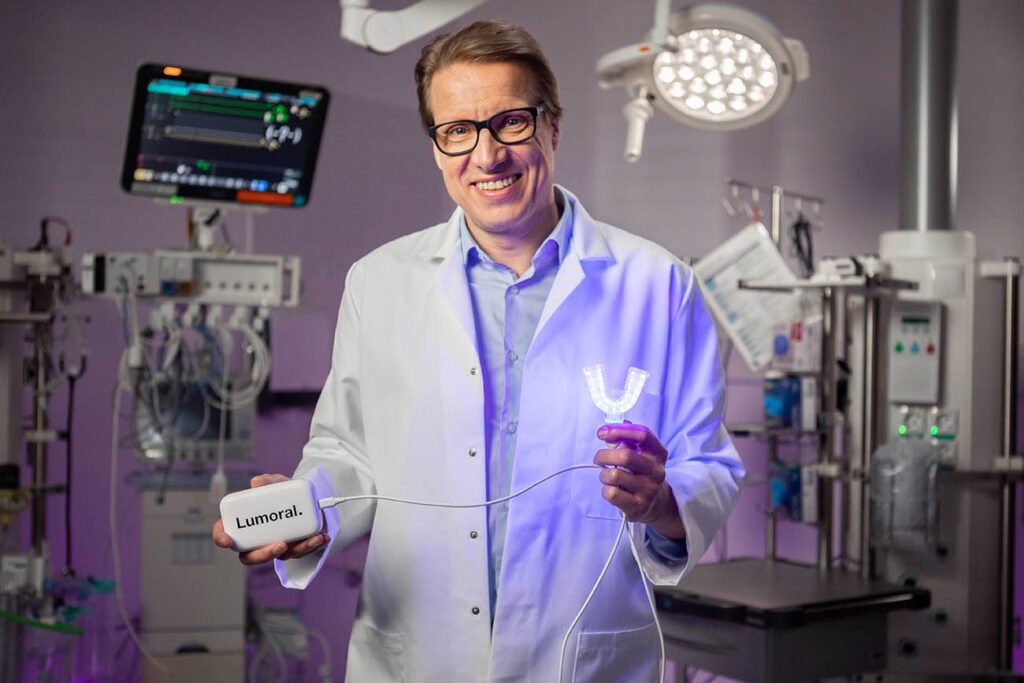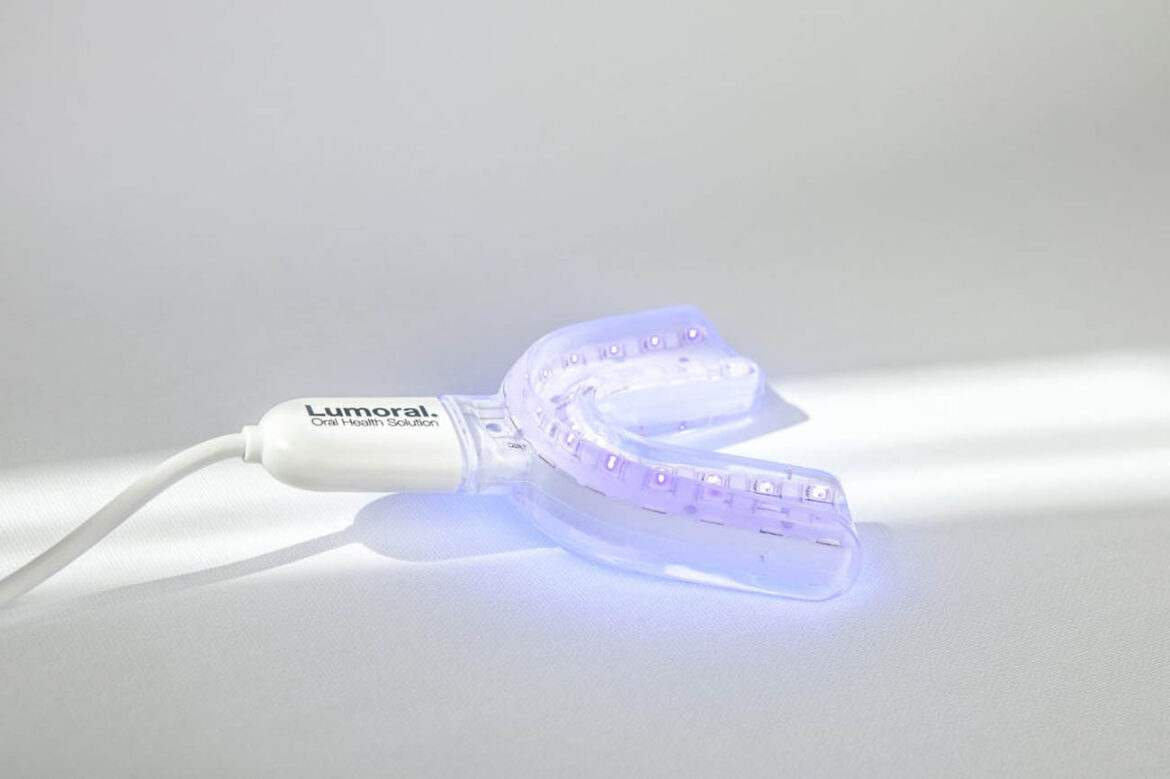A newly published breakthrough study shows that targeted elimination of bacteria contained in dental plaque should be as vital a part of dental hygiene as brushing your teeth and flossing. Finnish scientists have developed a new device to enable this: the Lumoral antibacterial teeth cleaning method brings professional-level oral hygiene to the comfort of your own home.
Europe’s largest periodontitis study is currently being carried out at Finland’s Metropolia University of Applied Sciences. The interim results of the three-year study indicate that regular use of home-applied dual-light photodynamic therapy reduces gingivitis and improves dental hygiene significantly. The treatment utilizes an efficient antibacterial method developed by Finnish researchers. Treatment eliminates disease-causing bacteria from dental plaque in a targeted manner, without having an effect on normal oral flora.
Periodontitis, a chronic infection caused by bacteria, is a disease that affects as many as 70% of people in Western countries. Periodontitis is the sixth most common disease in the world that can also lead to other conditions such as cardiovascular disease and diabetes. Because bacteria in the plaque cause 95 per cent of dental diseases, regularly eliminating dental plaque bacteria improves dental hygiene. It also prevents and treats dental and gum diseases.
“Brushing and flossing isn’t enough – more than half of the participants in the study achieved healthy gums after only three months of antibacterial treatment”
The peer-reviewed study covering the three-month results (n=59) is published in a special edition of Dentistry Journal. It shows that 54 percent of participants who used additional home-applied photodynamic therapy were healed from gingivitis based on the BOP (Bleeding on Probing) index – this represents 2.5 times more than in the control group. In the control group, only 22 percent of participants had healthy gums after the three-month study period.
The group of participants following the enhanced protocol, had a significantly lower amount of plaque build-up, whereas the control group still had the same amount of plaque left in their mouth.
– You can only remove half of the plaque by brushing your teeth – it’s no wonder cavities and gingivitis are among the most common diseases in the world. If we want to improve the results of dental care treatments, we need to focus on removing the plaque that is left on the teeth after brushing them, said Professor Timo Sorsa from the Department of Oral and Maxillofacial Diseases at the University of Helsinki.
– Our hypothesis was correct: because 95 percent of dental diseases are caused by bacteria in the plaque, regularly eliminating dental plaque improves dental hygiene as well as prevents and treats dental and gum diseases. The results are exceptional, and the report shows that the golden standard treatment can be significantly improved, explains heart surgeon Tommi Pätilä, who is one of the developers of the new home-applied antibacterial treatment.

Home-applied photodynamic therapy removes bacteria from where your toothbrush can’t reach
In periodontitis, advanced gingivitis damages strands of collagen – so called periodontal fibers – surrounding the teeth. This can lead to the deepening of gum pockets. As the disease advances, the infection causes a loss of tissue, and ultimately may lead to losing one or more teeth. Periodontitis is significantly common, as up to half of over 50-year-olds suffer from the disease.
Taking good care of dental hygiene is important, but in cases of advanced infection, gum pockets need to be regularly cleaned by a professional. However, cleaning gum pockets with traditional methods can be difficult, which leads to more bacteria filling the pockets, thus causing further infections.
– Periodontitis is often asymptomatic for long periods of time. Unfortunately, pain is often the first motivator to get treated, Sorsa continues.
The research shows that two out of three (67%) study participants using the new protocol were able to reduce the number of deep gum pockets by half compared to the initial situation. Four participants were able to completely eradicate deep gum pockets. The results are significantly better than in the participants in the control group.
– We want to permanently improve at-home dental hygiene. Previously, advanced gingivitis could only be treated at a dental clinic. This has caused challenges due to long waiting lists in public dental clinics and the high cost of treatment in private clinics. Using additional antibacterial treatment combined with receiving proper treatment from professionals reduces infections in the mouth, Pätilä says.
Six-month results of the ongoing study will be released in late-December to give further insight on the efficacy of the new treatment.
– We expect the further results to be even better after the participants have been applying the antibacterial at-home treatment regularly for six months, Pätilä concludes.
About the study and the home-applied dual-light antibacterial therapy
In the study carried out at Metropolia University of Applied Sciences, periodontitis is treated with the currently best-known methods. These include guiding the study participants to a proper toothbrushing technique and providing them with new, modern electric toothbrushes. The teeth and gum pockets of all participants are cleaned properly before the start of the study.
The teeth and gum pockets of all participants are cleaned properly before the start of the study. After that, the participants are divided into two groups. One of the groups utilizes the additional antibacterial method at home and the other group, which is a control group, doesn’t use the antibacterial treatment. The oral health of the participants’ is checked after three months and again after a six-month period.
Both groups consist of 100 participants that already suffer from periodontitis. The research is carried out in groups of 50. In the research, the health of each tooth is measured from six different measuring points. For example, if a participant has 25 teeth, they will have 150 measuring points in total. Inflammation of the gums is a sign of the periodontitis advancing and causing damage in the mouth.
The new method, called Lumoral, combines antibacterial photodynamic treatment (aPDT) with antibacterial blue light therapy (aBL). In Lumoral, the oral health-promoting near-infrared light light activates the photosensitive Lumorinse mouth rinse, triggering a reaction that eliminates harmful oral bacteria. The process is called antibacterial photodynamic therapy (aPDT). The simultaneous application of the antibacterial blue light enhances the antibacterial effect. Using aPDT, gives the unique benefit to target antibacterial effect on the dental plaque without causing harm to the normal oral flora. Such targeted effect enables regular home use. There is no similar product on the market, and similar treatment has previously only been provided at dental clinics.
To find out more about Lumoral click here.
